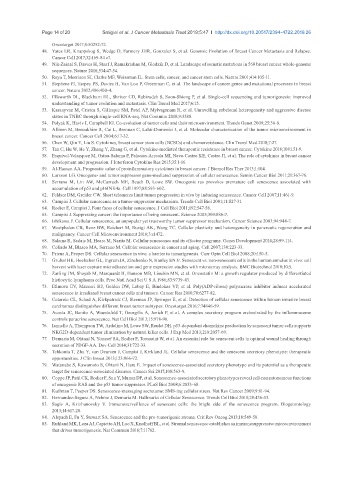Page 349 - Read Online
P. 349
Page 14 of 20 Smigiel et al. J Cancer Metastasis Treat 2019;5:47 I http://dx.doi.org/10.20517/2394-4722.2019.26
Oncotarget 2017;8:50252-72.
48. Yates LR, Knappskog S, Wedge D, Farmery JHR, Gonzalez S, et al. Genomic Evolution of Breast Cancer Metastasis and Relapse.
Cancer Cell 2017;32:169-84 e7.
49. Nik-Zainal S, Davies H, Staaf J, Ramakrishna M, Glodzik D, et al. Landscape of somatic mutations in 560 breast cancer whole-genome
sequences. Nature 2016;534:47-54.
50. Reya T, Morrison SJ, Clarke MF, Weissman IL. Stem cells, cancer, and cancer stem cells. Nature 2001;414:105-11.
51. Stephens PJ, Tarpey PS, Davies H, Van Loo P, Greenman C, et al. The landscape of cancer genes and mutational processes in breast
cancer. Nature 2012;486:400-4.
52. Ellsworth DL, Blackburn HL, Shriver CD, Rabizadeh S, Soon-Shiong P, et al. Single-cell sequencing and tumorigenesis: improved
understanding of tumor evolution and metastasis. Clin Transl Med 2017;6:15.
53. Karaayvaz M, Cristea S, Gillespie SM, Patel AP, Mylvaganam R, et al. Unravelling subclonal heterogeneity and aggressive disease
states in TNBC through single-cell RNA-seq. Nat Commun 2018;9:3588.
54. Polyak K, Haviv I, Campbell IG. Co-evolution of tumor cells and their microenvironment. Trends Genet 2009;25:30-8.
55. Allinen M, Beroukhim R, Cai L, Brennan C, Lahti-Domenici J, et al. Molecular characterization of the tumor microenvironment in
breast cancer. Cancer Cell 2004;6:17-32.
56. Chen W, Qin Y, Liu S. Cytokines, breast cancer stem cells (BCSCs) and chemoresistance. Clin Transl Med 2018;7:27.
57. Tan C, Hu W, He Y, Zhang Y, Zhang G, et al. Cytokine-mediated therapeutic resistance in breast cancer. Cytokine 2018;108:151-9.
58. Esquivel-Velazquez M, Ostoa-Saloma P, Palacios-Arreola MI, Nava-Castro KE, Castro JI, et al. The role of cytokines in breast cancer
development and progression. J Interferon Cytokine Res 2015;35:1-16.
59. Al-Hassan AA. Prognostic value of proinflammatory cytokines in breast cancer. J Biomol Res Ther 2013;1:104.
60. Larsson LG. Oncogene- and tumor suppressor gene-mediated suppression of cellular senescence. Semin Cancer Biol 2011;21:367-76.
61. Serrano M, Lin AW, McCurrach ME, Beach D, Lowe SW. Oncogenic ras provokes premature cell senescence associated with
accumulation of p53 and p16INK4a. Cell 1997;88:593-602.
62. Feldser DM, Greider CW. Short telomeres limit tumor progression in vivo by inducing senescence. Cancer Cell 2007;11:461-9.
63. Campisi J. Cellular senescence as a tumor-suppressor mechanism. Trends Cell Biol 2001;11:S27-31.
64. Rodier F, Campisi J. Four faces of cellular senescence. J Cell Biol 2011;192:547-56.
65. Campisi J. Suppressing cancer: the importance of being senescent. Science 2005;309:886-7.
66. Ishikawa F. Cellular senescence, an unpopular yet trustworthy tumor suppressor mechanism. Cancer Science 2003;94:944-7.
67. Westphalen CB, Renz BW, Reichert M, Rustgi AK, Wang TC. Cellular plasticity and heterogeneity in pancreatic regeneration and
malignancy. Cancer Cell Microenvironment 2016;3:e1472.
68. Salama R, Sadaie M, Hoare M, Narita M. Cellular senescence and its effector programs. Genes Development 2014;28:99-114.
69. Collado M, Blasco MA, Serrano M. Cellular senescence in cancer and aging. Cell 2007;130:223-33.
70. Prieur A, Peeper DS. Cellular senescence in vivo: a barrier to tumorigenesis. Curr Opin Cell Biol 2008;20:150-5.
71. Gruber HE, Hoelscher GL, Ingram JA, Zinchenko N, Hanley EN Jr. Senescent vs. non-senescent cells in the human annulus in vivo: cell
harvest with laser capture microdissection and gene expression studies with microarray analysis. BMC Biotechnol 2010;10:5.
72. Zarling JM, Shoyab M, Marquardt H, Hanson MB, Lioubin MN, et al. Oncostatin M: a growth regulator produced by differentiated
histiocytic lymphoma cells. Proc Natl Acad Sci U S A 1986;83:9739-43.
73. Efimova EV, Mauceri HJ, Golden DW, Labay E, Bindokas VP, et al. Poly(ADP-ribose) polymerase inhibitor induces accelerated
senescence in irradiated breast cancer cells and tumors. Cancer Res 2010;70:6277-82.
74. Cotarelo CL, Schad A, Kirkpatrick CJ, Sleeman JP, Springer E, et al. Detection of cellular senescence within human invasive breast
carcinomas distinguishes different breast tumor subtypes. Oncotarget 2016;7:74846-59.
75. Acosta JC, Banito A, Wuestefeld T, Georgilis A, Janich P, et al. A complex secretory program orchestrated by the inflammasome
controls paracrine senescence. Nat Cell Biol 2013;15:978-90.
76. Iannello A, Thompson TW, Ardolino M, Lowe SW, Raulet DH. p53-dependent chemokine production by senescent tumor cells supports
NKG2D-dependent tumor elimination by natural killer cells. J Exp Med 2013;210:2057-69.
77. Demaria M, Ohtani N, Youssef SA, Rodier F, Toussaint W, et al. An essential role for senescent cells in optimal wound healing through
secretion of PDGF-AA. Dev Cell 2014;31:722-33.
78. Tchkonia T, Zhu Y, van Deursen J, Campisi J, Kirkland JL. Cellular senescence and the senescent secretory phenotype: therapeutic
opportunities. J Clin Invest 2013;123:966-72.
79. Watanabe S, Kawamoto S, Ohtani N, Hara E. Impact of senescence-associated secretory phenotype and its potential as a therapeutic
target for senescence-associated diseases. Cancer Sci 2017;108:563-9.
80. Coppe JP, Patil CK, Rodier F, Sun Y, Munoz DP, et al. Senescence-associated secretory phenotypes reveal cell-nonautonomous functions
of oncogenic RAS and the p53 tumor suppressor. PLoS Biol 2008;6:2853-68.
81. Kuilman T, Peeper DS. Senescence-messaging secretome: SMS-ing cellular stress. Nat Rev Cancer 2009;9:81-94.
82. Hernandez-Segura A, Nehme J, Demaria M. Hallmarks of Cellular Senescence. Trends Cell Biol 2018;28:436-53.
83. Sagiv A, Krizhanovsky V. Immunosurveillance of senescent cells: the bright side of the senescence program. Biogerontology
2013;14:617-28.
84. Alspach E, Fu Y, Stewart SA. Senescence and the pro-tumorigenic stroma. Crit Rev Oncog 2013;18:549-58.
85. Ruhland MK, Loza AJ, Capietto AH, Luo X, Knolhoff BL, et al. Stromal senescence establishes an immunosuppressive microenvironment
that drives tumorigenesis. Nat Commun 2016;7:11762.

